Nzinda | |
|---|---|
| Country | |
| Province | Kwilu |
| City | Kikwit |
| Time zone | UTC+1 (West Africa Time) |
Nzinda or Nzida is a commune and a town in the city of Kikwit in the Democratic Republic of Congo. [1] [2] [3] [4]
Nzinda | |
|---|---|
| Country | |
| Province | Kwilu |
| City | Kikwit |
| Time zone | UTC+1 (West Africa Time) |
Nzinda or Nzida is a commune and a town in the city of Kikwit in the Democratic Republic of Congo. [1] [2] [3] [4]

The Third Republic of the Democratic Republic of the Congo is a unitary state with a five-level hierarchy of types of administrative division. There are nine different types of country subdivision in a new hierarchy with no new types but with two from the previous one abolished.

Direct elections in the Democratic Republic of the Congo occur for the Presidency, National Assembly, and provincial assemblies. The Senate, the upper house of the legislature, is elected indirectly by members of the provincial assemblies.
The Movement for the Liberation of the Congo is a political party in Democratic Republic of the Congo. Formerly a rebel group operating in the Democratic Republic of Congo that fought the government throughout the Second Congo War, it subsequently took part in the transitional government and is one of the main opposition parties.
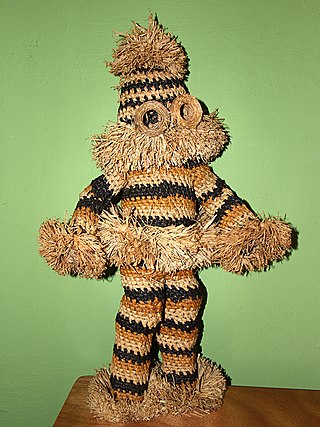
Kikwit is the largest city of Kwilu Province, lying on the Kwilu River in the southwestern part of the Democratic Republic of the Congo. Kikwit is also known in the region under the nickname "The Mother". The population is approximately 458,000 (2017). An important commercial centre, it is home to a stadium and is known for its traditional dances, in particular the Bapende dancers whose geographic origin centers on the village of Gungu. Bapende dancers often wear traditional costumes comprising colorful masks and attire made from raffia. Kikwit is also home to an airport and is connected to the capital Kinshasa by a new road and river transport.
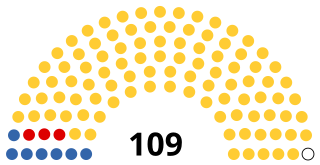
The Senate is the upper house of the Parliament of the Democratic Republic of the Congo. The senate was established in 1960, abolished in 1967 and re-established in 2003.
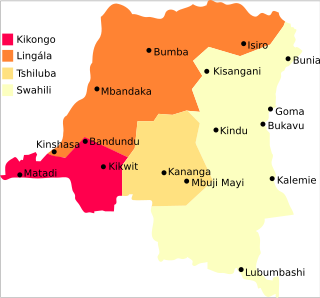
The Democratic Republic of the Congo is a multilingual country where an estimated total of 242 languages are spoken. Ethnologue lists 215 living languages. The official language, inherited from the colonial period, is French. Four other languages, three of them indigenous, have the status of national language: Kikongo, Lingala, Swahili and Tshiluba.
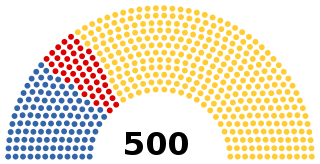
The National Assembly is the lower house and main legislative political body of the Parliament of the Democratic Republic of the Congo. It was established by the 2006 constitution.

Radio Okapi is a radio network that operates in the Democratic Republic of the Congo. On an annual budget of USD$4.5 million, a staff of 200 provide news and information to the entire urban population of the DRC. Radio Okapi provides programming in French and in the four national languages of Congo: Lingala, Kituba, Swahili and Tshiluba,
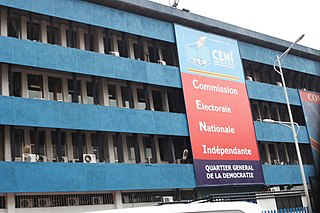
The Independent National Electoral Commission is the body that runs elections in the Democratic Republic of the Congo.

Lemba is one of the 24 communes that are the administrative divisions of Kinshasa, the capital city of the Democratic Republic of the Congo.

Limete is one of the 24 communes that are the administrative divisions of Kinshasa, the capital city of the Democratic Republic of the Congo.

Matete is one of the 24 communes that are the administrative divisions of Kinshasa, the capital city of the Democratic Republic of the Congo.
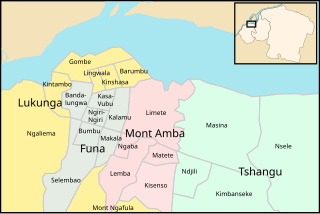
Mont Amba is an area of the capital city of Kinshasa, Democratic Republic of the Congo, comprising five of the city-province's twenty-four administrative divisions—the communes of Kisenso, Lemba, Limete, Matete and Ngaba. It is one of the four so-called districts of Kinshasa. These were the administrative divisions of Kinshasa during much of the Mobutu years (1965-1997) and around which a number of government systems and services are still organized. For instance, Mont Amba makes up an eleven-member National Assembly constituency designated as Kinshasa III. However, these districts are not part of Congo's territorial organization.

Tshangu is an area of the capital city of Kinshasa, Democratic Republic of the Congo, comprising five of the city-province's twenty-four administrative divisions—the communes of Kimbanseke, Maluku, Masina, Ndjili and Nsele. It is one of the four so-called districts of Kinshasa. These were the administrative divisions of Kinshasa during much of the Mobutu years (1965-1997) and around which a number of government systems and services are still organized. For instance, Tshangu makes up an eighteen-member National Assembly constituency designated as Kinshasa IV. However, these districts are not part of Congo's territorial organization.

Lukunga is an area of the capital city of Kinshasa, Democratic Republic of the Congo, comprising seven of the city-province's twenty-four administrative divisions—the communes of Barumbu, Gombe, Kinshasa, Kintambo, Lingwala, Mont Ngafula and Ngaliema. It is one of the four so-called districts of Kinshasa. These were the administrative divisions of Kinshasa during much of the Mobutu years (1965-1997) and around which a number of government systems and services are still organized. For instance, Lukunga makes up a fourteen-member National Assembly constituency designated as Kinshasa I. However, these districts are not part of Congo's territorial organization.

Funa is an area of the capital city of Kinshasa, Democratic Republic of the Congo, comprising seven of the city-province's twenty-four administrative divisions—the communes of Bandalungwa, Bumbu, Kalamu, Kasa-Vubu, Makala, Ngiri-Ngiri and Selembao. It is one of the four so-called districts of Kinshasa. These were the administrative divisions of Kinshasa during much of the Mobutu years (1965-1997) and around which a number of government systems and services are still organized. For instance, Funa makes up a twelve-member National Assembly constituency designated as Kinshasa II. However, these districts are not part of Congo's territorial organization.
Luiza is a territory of Kasai-Central province of the Democratic Republic of the Congo. It covers an area of 14,702 square kilometers. As of March 2021, its inhabitants numbered 1,515,339. It is represented in the National Assembly by four elected deputies.

Gubernatorial elections took place in 11 out of the 26 provinces of the Democratic Republic of the Congo on 26 August 2017, with a second round held in three provinces on August 29. Elections in three other provinces were not held until 21 December 2017. The elections occurred after several governors had been dismissed. Applications of potential candidates were submitted to the Independent National Electoral Commission from 21 to 25 July 2017, with a period for the review of the applications from 26 to 30 July. On August 2, the list of candidates was published and the following two days were granted for any appeals. More than half of the provinces were won by candidates of the Alliance of the Presidential Majority, though some went to independent opposition candidates.
Seth Kikuni is a Congolese entrepreneur, businessman, and politician who was one of the candidates in the 2018 Democratic Republic of the Congo presidential election. He was the youngest candidate.

General elections are expected to be held in the Democratic Republic of the Congo on 20 December 2023 according to the electoral calendar released 26 November 2022 by the Independent National Electoral Commission (CENI). Simultaneous elections will be held for the President, the 500 members of the National Assembly, the elected members of the 26 provincial assemblies, and, for the first time under the new constitution, members of around 300 commune (municipal) councils.